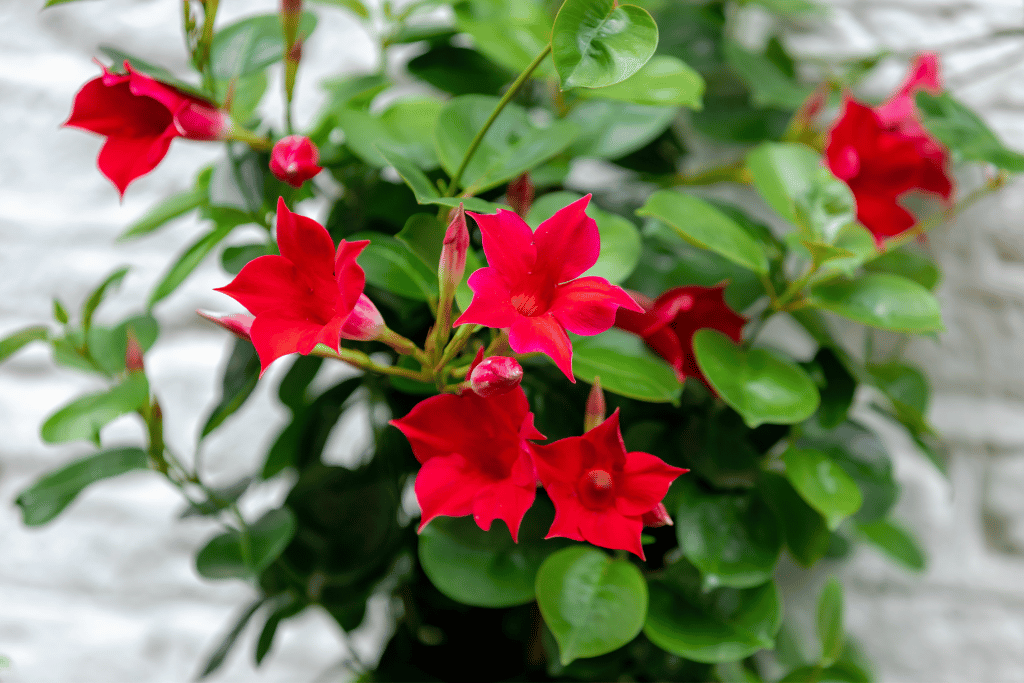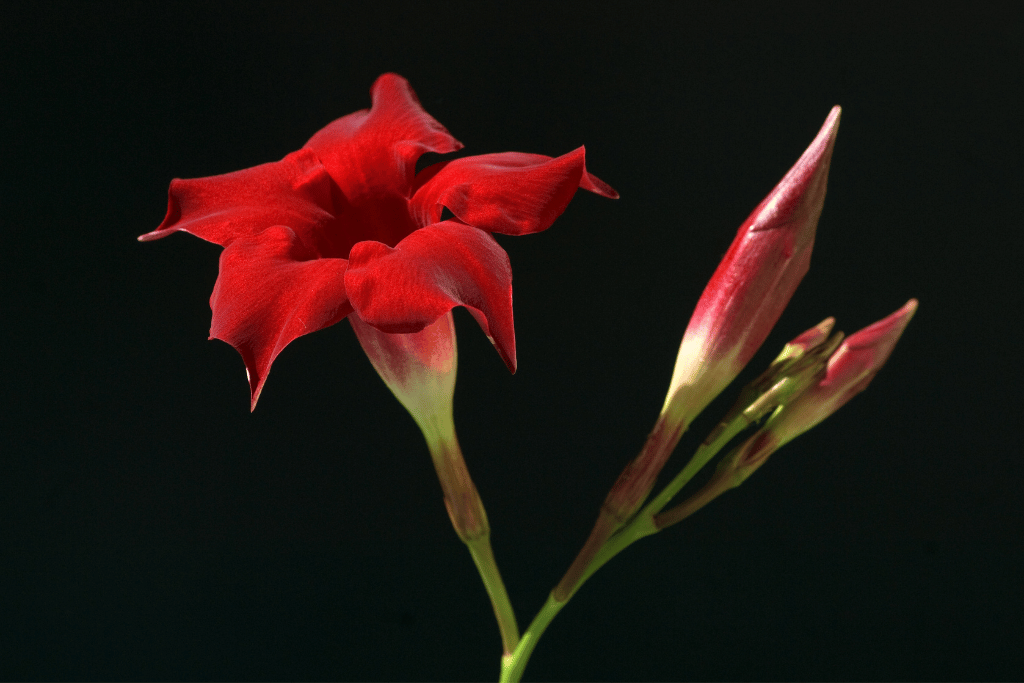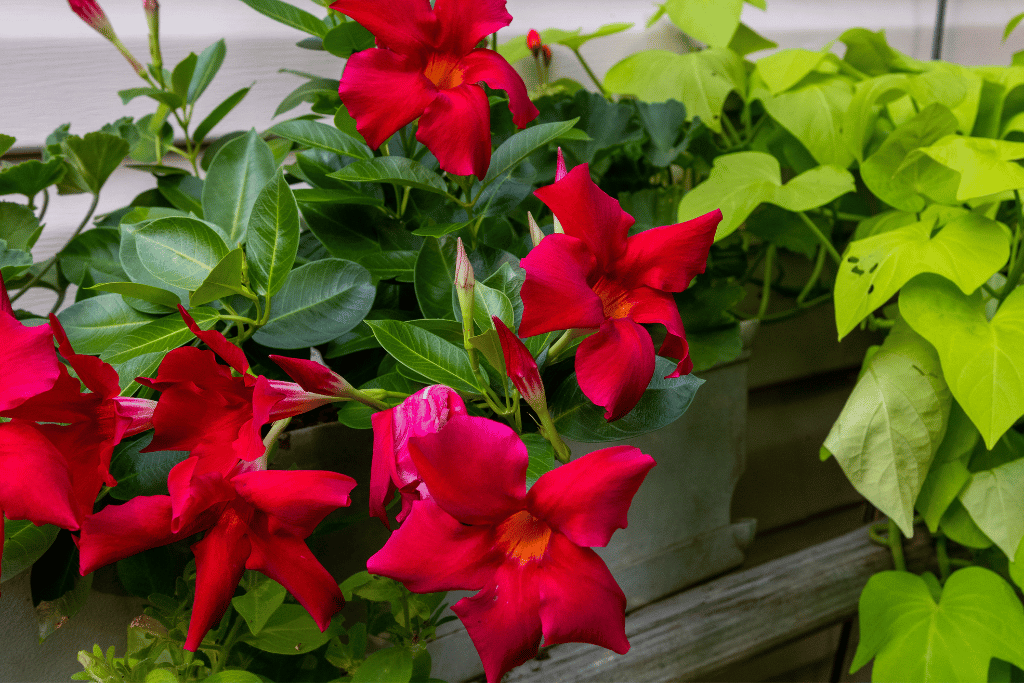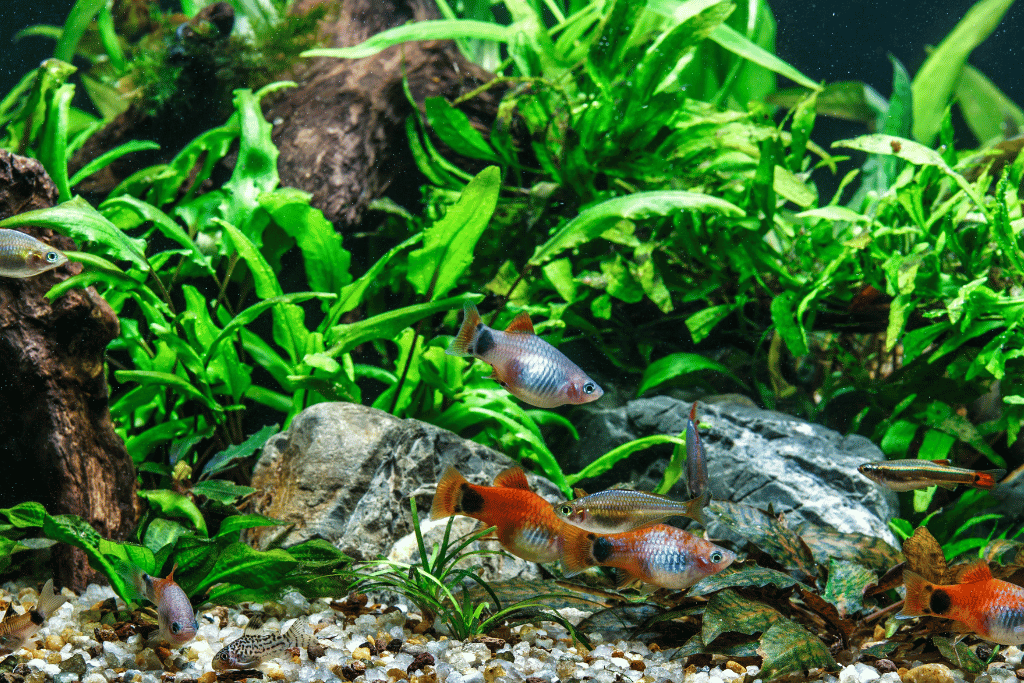
I want to share my story about a special plant I adore – the Rio Dipladenia. This plant has a way of catching everyone’s eye with its stunning looks. It can be placed on a balcony, windowsill, or anywhere you like. The Rio Dipladenia is like a piece of art that I’ve learned how to take care of, making sure it stays healthy and beautiful.
The Rio Dipladenia is sometimes called by its fancy name (Brazilian Jasmine or Mandevilla), but it’s really just a wonderful plant from South America. It loves the warm sun, and the good thing is you can keep it inside your home or outside in a garden. It’s perfect for both experts in gardening and beginners who are just starting to try growing plants. It’s like having a new friend to take care of!
I’ve spent time learning all about this plant, from how to plant it in the right soil to when to water it. It’s been a rewarding journey, and I’m excited to share what I’ve learned so that you can enjoy the beauty of the Rio Dipladenia too.
So, if you’re curious about plants or you already love gardening, the Rio Dipladenia plant is a fantastic choice. It has brought so much happiness to my space, teaching me about taking things slow, looking after living things, and the joy of watching it bloom. My adventure with the Rio Dipladenia continues, full of learning, beauty, and a strong connection to nature.
Rio Dipladenia Overview

I’m excited to show you the wonderful world of the Rio Dipladenia plant. This plant, also called Mandevilla ‘Rio’, is really amazing. It comes from South America, especially Brazil. It has a fancy scientific name, Dipladenia sanderi, which honors a special person who introduced it to the world.
What the Rio Dipladenia Looks Like and How It Grows?
The Rio Dipladenia plant is like a nature superstar! It’s not too tall, usually around 1 to 2 feet. It has pretty leaves that are shiny and green. But the best part is its flowers. They look like trumpets and come in lots of colors, like red, pink, and white. These flowers make the plant look really special.
Cool Things to Know About the Rio Dipladenia Plant
Here are some interesting facts to know about the Rio Dipladenia plant:
Lots of Colors: The Rio Dipladenia flowers have many colors, making them super pretty.
Blooms All the Time: This plant is like a party animal – it blooms a lot, from late spring to early fall.
Loves Sunlight: The Rio Dipladenia likes the sun, so put it where it can get at least 4 hours of sun every day.
Perfect for Pots: If you don’t have a big garden, don’t worry! You can grow the Rio Dipladenia in pots on your porch or balcony.
Warm Weather Fan: Keep this plant warm. Don’t let it get colder than 45°F.
Water Just Right: Give it water, but don’t drown it. Wait until the top part of the soil is a bit dry before watering again.
Likes to Climb: This plant loves to climb things. You can help it by giving it something to hold onto, like a trellis.
Comes Back Every Year: The Rio Dipladenia is like a gift that keeps on giving – it comes back year after year with the right care.
Rio Dipladenia Appearance

A plant with lush, glossy leaves and vibrant, eye-catching flowers that come in various shades. That’s Rio Dipladenia for you! This lovely plant features thick, dark green leaves that shine under the sun, creating a lush backdrop for its colorful blooms. The leaves are smooth to the touch, adding a touch of elegance to its overall appearance.
Furthermore, Rio Dipladenia is all about flaunting its fabulous flowers. The blooms come in an array of shades, from delicate pinks and creamy whites to deep reds. Each flower is like a little work of art, with intricate patterns and a unique beauty that will surely capture your heart.
Types of Rio Dipladenia Available

Alright, plant enthusiasts, it’s time to explore the exciting world of Rio Dipladenia varieties. There are quite a few cultivars out there, and I’m here to introduce you to some of the standout options.
Mandevilla ‘Red Riding Hood’ – Pale Red Beauty
Let’s start with Mandevilla ‘Red Riding Hood.’ This variety boasts pale red blooms that are simply enchanting. Imagine delicate flowers in a soft red hue, adding a touch of warmth and elegance to your garden. It’s a showstopper that’s sure to turn heads.
My Fair Lady – Elegance in Pink and White
Next up is the charming ‘My Fair Lady.’ This cultivar brings together pink buds, yellow throats, and white flowers in a delightful harmony. The combination of colors creates a stunning contrast that’s sure to make your garden a focal point of beauty.
Tropidenia – Pretty in Pink
If you’re a fan of pink, you’ll adore the Tropidenia variety. This one showcases lovely pink flowers that are a true delight to behold. It’s a perfect choice if you’re looking to infuse your outdoor space with a pop of feminine charm.
Sundaville ‘Moulin Rouge’ – Scarlet Elegance
For a bold and dramatic statement, consider Sundaville ‘Moulin Rouge.’ This variety boasts scarlet red velvety flowers with a clear throat and chalice-like shape. It’s a true showpiece that adds a touch of drama and sophistication to any garden.
Sundaville ‘Dark Red’ – Deep and Mysterious
If you’re drawn to deeper shades, Sundaville ‘Dark Red’ is the one for you. Its dark red flowers exude a sense of mystery and allure, creating a captivating focal point in your outdoor space.
Sundaville ‘Cream Pink’ – Soft and Subtle
For those who appreciate a more delicate palette, Sundaville ‘Cream Pink’ is a perfect choice. This variety features pale pink flowers that bring a sense of serenity and softness to your garden.
Alba – Elegance in White
White flowers never go out of style, and the Alba variety of Rio Dipladenia is a testament to that. With its pure white blooms, Alba exudes timeless elegance and sophistication, making it a versatile choice for any garden style.
Rosea – Graceful Pale Pink
Last but not least, we have Rosea. This cultivar showcases pale pink flowers with a yellowish throat, creating a graceful and charming look that’s sure to capture your heart.
Interesting Knowledge About Rio Dipladenia

Are rio dipladenia poisonous to cats?
Yes, Rio Dipladenia plants can be harmful to cats if they chew or nibble on them. The plant contains substances that might lead to stomach upset, vomiting, or other discomfort. To ensure your furry friends’ safety, it’s advisable to place the plant in an area that’s out of their reach or opt for cat-friendly plants instead.
Do hummingbirds like rio dipladenia?
Absolutely! Hummingbirds are naturally drawn to the vibrant and showy flowers of Rio Dipladenia. These lively birds are attracted by the plant’s colorful and nectar-rich blooms. By having Rio Dipladenia in your garden, you can create a delightful haven that entices these tiny avian visitors to flutter by regularly.
How long do rio Dipladenia last?
Rio Dipladenia plants have a decent lifespan when properly cared for. With the right conditions, they can thrive and produce their eye-catching flowers for multiple years. These blossoms typically grace your garden during the warmer months, treating you to an extended display of their beauty that can span a significant portion of the year.
Are rio dipladenia perennials?
In most areas, Rio Dipladenia is treated as an annual plant, meaning it completes its life cycle within a single growing season. However, in regions with milder winters, it may behave more like a perennial, regrowing and blooming for several years. This variability allows gardeners to enjoy its charming flowers either as a temporary treat or a more enduring presence.
How to Overwinter Rio dipladenia?
As colder weather approaches, you can help your Rio Dipladenia transition through winter by bringing it indoors. Find a sunny indoor spot, and water the plant moderately to prevent its roots from drying out. While you might notice some leaf drop during this period, don’t worry – come spring, with proper care and attention, your Rio Dipladenia should rebound and continue to grace your garden with its vibrant blooms.
How to Grow Rio Dipladenia – A Complete Guide

Growing Rio Dipladenia is a delightful journey that brings vibrant beauty to your space. Whether you choose to plant it in the ground or in pots, each method has its own perks. Let’s explore step by step how to grow Rio Dipladenia in each setting, along with its key requirements.
Growing in the Ground: Step by Step
Planting Rio Dipladenia directly in the ground can create a stunning natural display in your garden. Here’s a simple guide to get you started:
1. Choose the Right Spot: Pick a spot with well-draining soil and good sunlight. Rio Dipladenia loves sunshine, so a place that gets 6-8 hours of direct sunlight is ideal.
2. Prepare the Soil: Make sure the soil is loose and well-draining. You can add some compost or sand to improve drainage if needed.
3. Dig a Hole: Dig a hole that’s slightly larger than the plant’s root ball. Make sure it’s deep enough for the plant to sit at the same level it was in the pot.
4. Planting: Gently remove the plant from its pot and place it in the hole. Fill in the hole with soil and pat it down gently to secure the plant.
5. Watering: Give the plant a good drink of water right after planting. After that, water it regularly, keeping the soil evenly moist but not soggy.
6. Support: As the plant grows, you can provide support with a stake or trellis for it to climb.
7. Pruning: Trim any dead or overgrown branches to encourage healthy growth.
Growing in Pots: Step by Step
Planting Rio Dipladenia in pots offers flexibility and easy maintenance. Follow these steps for successful pot cultivation:
1. Choose the Right Pot: Opt for a pot that’s a bit larger than the plant’s current container. Make sure it has drainage holes at the bottom.
2. Potting Mix: Use a well-draining potting mix with ingredients like compost and sand. Fill the pot about halfway.
3. Planting: Gently remove the plant from its current pot and place it in the new pot. Fill the rest of the pot with soil, leaving about an inch of space at the top.
4. Watering: Water the plant thoroughly after planting, until you see water draining out of the bottom. Keep the soil consistently moist, but not soggy.
5. Sunlight: Place the pot in a spot that gets 6-8 hours of sunlight. If it’s really hot, some afternoon shade might be beneficial.
6. Support and Training: If you want your Rio Dipladenia to climb or cascade, provide a trellis or hanging support. You can gently guide the vines as they grow.
7. Pruning: Regularly trim any dead or straggly branches to encourage new growth.
Rio Dipladenia Growing Requirements

Now that we’ve covered the basics of growing Rio Dipladenia in the ground and pots, let’s dive into the key features and requirements that will help your plant thrive.
Sunlight: Bringing on the Sunshine
Rio Dipladenia is a sun-loving plant that craves sunlight for its growth and blooming. Whether you’re planting it in the ground or in a pot, providing ample sunlight is essential. Here’s what you need to know:
- In the Ground: Choose a sunny spot in your garden where the plant can receive 6-8 hours of direct sunlight each day. This helps in robust growth and abundant flowering.
- In Pots: If you’re growing Rio Dipladenia in pots, place the pot in an area that gets the same amount of sunlight – around 6-8 hours. Morning sun and late afternoon sun are particularly good options.
Remember, while Rio Dipladenia loves sunlight, if you live in an extremely hot region, it’s a good idea to provide some shade during the hottest part of the day to prevent the leaves from getting scorched.
Water: Quenching Their Thirst
Proper watering is key to keeping your Rio Dipladenia happy and healthy. Let’s explore how to give them the right amount of water:
- In the Ground: Water the plant regularly, especially during dry spells. Aim to keep the soil consistently moist, but not waterlogged. Check the top few inches of soil – if it feels dry, it’s time to water.
- In Pots: Potted Rio Dipladenia may need more frequent watering compared to those in the ground. Water the plant thoroughly until water drains out of the bottom of the pot. As with the ground planting, check the top inches of soil to determine when to water next.
A helpful tip: If you’re not sure whether to water, it’s better to wait a bit longer. These plants can handle a bit of drought, but they don’t like soggy roots.
Soil: Creating a Cozy Home for Roots
Good soil is like a cozy home for your Rio Dipladenia’s roots. Let’s look at how to create the right soil environment:
- In the Ground: Choose well-draining soil that isn’t too heavy. You can mix in some compost or sand to improve drainage if needed.
- In Pots: Use a high-quality potting mix that’s specifically designed for container plants. These mixes usually have good drainage and aeration properties.
Remember to avoid compacted or clayey soil, as it can lead to waterlogging and root problems.
Humidity: Nature’s Own Way
Unlike some plants that demand high humidity, Rio Dipladenia is pretty chill about it. Here’s what you need to know:
- In the Ground and in Pots: Rio Dipladenia doesn’t need extra humidity. It’s adapted to various humidity levels and can handle regular household or garden humidity just fine.
So, no need to invest in misting or humidifiers – your Rio Dipladenia will be content with the natural humidity levels around it.
Temperature: Finding the Comfort Zone
Getting the temperature right is important for Rio Dipladenia’s well-being. Let’s explore the temperature range that keeps them happy:
- In the Ground and in Pots: Rio Dipladenia prefers temperatures that are not too hot and not too cold. If you’re comfortable, chances are your plant is comfortable too.
During winter, if you’re growing your Rio Dipladenia outdoors and you expect frost or chilly temperatures, it’s a good idea to bring them inside to protect them from the cold. They prefer temperatures above 45°F (7°C).
Fertilizer: Giving Them a Little Boost
Fertilizing your Rio Dipladenia can help them grow strong and produce beautiful blooms. Here’s how to go about it:
- In the Ground and in Pots: Use a balanced, all-purpose liquid fertilizer. During the active growing season – which is usually spring and summer – feed your plant about once a month.
- Special Care: If you want your Rio Dipladenia to flower even more, you can use a fertilizer with a bit more phosphorus. Look for fertilizers with numbers like 7-9-5 or 6-10-4 – these indicate the ratio of nutrients in the fertilizer.
Remember not to over-fertilize, especially during winter when your plant is resting. It’s better to give them a bit less fertilizer than too much.
Growing Rio Dipladenia can be an amazing experience. Now that you know the procedure of growing it in both ground and in a pot, what are you waiting for?
Repotting Your Rio Dipladenia Plant: A Nutrient Boost for Continued Growth

Repotting is an essential practice for ensuring the ongoing health and vitality of your beloved Rio dipladenia plant. Even though this plant is known for its gradual growth, the benefits of repotting should not be overlooked. This annual ritual serves to refresh the plant’s nutrient supply and prevent the accumulation of salts that can arise from regular fertilization.
Let’s go through the ins and outs of repotting your Rio dipladenia, and look at the simple steps to keep your plant thriving.
Timing Is Everything: Choosing the Right Moment for Repotting
Timing plays a crucial role when it comes to repotting your Rio dipladenia. To ensure a smooth transition and minimal shock to your plant, the best time for repotting is during early spring, just as the plant emerges from its dormant phase. By repotting at this point, you give your Rio dipladenia ample time to recover and adjust to its new environment before the arrival of colder winter months. This strategic approach can set the stage for a healthy growing season.
The Tools You’ll Need: Equipping Yourself for Success
Gathering the necessary tools for repotting is an essential preparatory step. A few basic houseplant tools can make the repotting process smoother and more efficient. Gloves provide protection for your hands, a new pot (one size larger if your plant is still growing in height) accommodates the plant’s increased size, fresh soil mix replenishes nutrients, and a source of water ensures hydration.
Step-by-Step Guide: A Gentle Transition for Your Rio Dipladenia
Hydration Precautions: Before commencing the repotting process, it’s crucial to ensure your Rio dipladenia is well-hydrated. Adequate hydration minimizes transplant shock, a common occurrence when plants are moved to new pots.
- Gentle Extraction: Gently remove the plant from its current pot by tilting the container to one side and carefully easing the plant out, including any trellis it may have.
- New Pot Preparation: Fill the new pot with fresh potting mix, leaving ample space for the plant’s root ball.
- Transplanting: Carefully place the plant, along with its trellis if applicable, into the new pot. Ensure that the plant sits at the same depth as before and fill in the remaining space with potting mix.
- Hydration Redux: Thoroughly water the plant post-repotting. This aids in settling the soil and eliminating air pockets around the roots.
- Returning to its Habitat: Place your newly repotted Rio dipladenia back in its original location, where it can continue to receive the appropriate amount of sunlight and care.
- Repotting might seem like a daunting task, but by following these simple steps, you can ensure your Rio dipladenia’s continued growth and vibrancy.
Propagation: Growing Your Rio Dipladenia Family Tree

The ability to propagate your Rio dipladenia is a source of joy for many plant enthusiasts. This technique allows you to create new plants from cuttings, contributing to a thriving garden ecosystem. In this section, I’ll walk you through the propagation process, step by step, so you can expand your Rio dipladenia collection and provide a welcoming haven for pollinators.
Creating New Growth: The Art of Propagation
- Selecting the Right Stem: Begin by choosing a healthy stem with abundant leaves. To ensure successful propagation, make a clean cut at a 45° angle to promote optimal absorption.
- Harnessing the Power of Rooting Hormone: Dip the cut end of the stem in a rooting hormone. This natural substance encourages the growth of roots, expediting the propagation process.
- Preparing Nursery Pots: Fill nursery pots with a suitable seed starting mix. Alternatively, concoct your own mix by combining equal parts of horticultural sand, perlite, and peat moss.
- Planting the Cuttings: Gently plant the prepared cuttings in the pots and water them thoroughly. Place the pots in a well-lit area to provide the necessary light for growth.
- Creating an Ideal Environment: Encourage growth by covering the pots with a humidity dome or plastic wrap. This increases humidity, creating a nurturing atmosphere for root development.
To further enhance the process, consider placing the pots on a heating mat to maintain a consistent temperature.
- Monitoring and Nurturing: Regularly monitor the cuttings and water them as needed to prevent the soil from drying out. Lift the cover periodically to introduce fresh air, which supports overall plant health.
- Transplanting for Success: Once you observe significant new growth, exercise patience and wait a bit longer before transplanting the cuttings into larger pots. This stage marks the transition to a more mature and robust plant.
Through propagation, you have the power to cultivate a flourishing family of Rio dipladenia plants, fostering a vibrant and lively garden environment.
Pruning Your Rio Dipladenia Plant: Sculpting for Health and Beauty

Pruning serves as a fundamental aspect of Rio dipladenia care, contributing to the plant’s overall well-being and aesthetic appeal. In this section, I’ll delve into the art of pruning, sharing insights on its benefits, techniques, and tips for maintaining your Rio dipladenia’s natural splendor.
Why Prune: The Purpose Behind Pruning
Pruning plays a pivotal role in promoting the health and vitality of your Rio dipladenia plant. By carefully removing specific portions of the plant, you facilitate improved airflow and sunlight penetration. This essential step ensures that even the innermost parts of the plant receive the nourishment they need, resulting in a thriving and exuberant Rio dipladenia.
Tools to Simplify the Process: Secateurs for Arthritic Hands
For those who find pruning a bit challenging or experience discomfort in their hands, utilizing specialized tools can make the process more manageable. Secateurs designed for arthritic hands offer ergonomic handles that require less hand pressure, enabling you to prune with ease and comfort.
Pruning Techniques: Sculpting for Health and Growth
Trimming Side Shoots: Focus your pruning efforts on the top and side shoots of your Rio dipladenia. Trim these shoots down to 2-3 leaves, as these trimmed sections will sprout new leaves and flowers from the dormant buds.
Shape Your Plant: You have the creative freedom to prune your Rio dipladenia according to your preference. Some gardeners opt to follow the natural shape of the trellis the plant is growing on, resulting in an organized and visually appealing appearance.
Embrace Natural Flower Fall: A remarkable feature of the Rio dipladenia is its self-maintaining nature. Unlike many other plants, you can leave dried and dead flowers untouched. They will naturally detach from the plant, eliminating the need for deadheading.
Additional Pruning Tips: Nurturing Your Rio Dipladenia
Mindful Pruning Frequency: While pruning is beneficial, avoid over-pruning your Rio dipladenia, as excessive cutting can hinder its overall growth and development.
Regular Inspection: Make it a habit to regularly inspect your plant for any signs of dead or diseased branches. Promptly removing these sections helps maintain the plant’s health and appearance.
Seasonal Pruning: Consider a more comprehensive pruning session during the plant’s dormant period to rejuvenate its growth and ensure a vibrant display in the upcoming growing season.
Pruning is an artistic and nurturing practice that contributes to the longevity and allure of your Rio dipladenia plant.
Diseases and Pests: Guardianship for a Thriving Rio Dipladenia

While caring for your Rio dipladenia plant brings immense joy, it’s important to address potential challenges posed by pests and diseases. In this section, I’ll guide you through preventive measures and strategies to deal with these unwelcome visitors, ensuring the continued health and vitality of your beloved plant.
Safeguarding Against Pests: A Proactive Approach
Pests, such as aphids and spider mites, can pose a threat to the well-being of your Rio dipladenia. However, a proactive approach to plant care can significantly minimize the risk of infestations. By providing your plant with adequate water and sunlight, you create an environment that is less inviting to these pests.
Harnessing Natural Allies: Introducing Ladybugs
Nature offers a remarkable solution for pest control – the ladybug. These vibrant insects are natural predators of aphids and spider mites, making them valuable allies in your garden. Introduce ladybugs to your outdoor space to help keep these nuisances in check and maintain a balanced ecosystem.
Nurturing and Treatment: Responding to Infestations
In the unfortunate event of a pest infestation, prompt action is key. For smaller infestations, you can use a simple Q-tip dipped in rubbing alcohol or neem oil to remove pests. However, for more substantial infestations, employing appropriate pesticides can effectively manage the issue.
Guarding Against Diseases: Preventing Anthracnose
Anthracnose is a common disease that can affect your Rio dipladenia, manifesting as brownish leaf spots, lesions, and even foliage loss. Preventing this issue revolves around keeping the plant’s leaves dry. Avoid overhead watering, splashing, and wetting the foliage to minimize the risk of anthracnose.
Action Steps for Disease Management
Isolation and Pruning: If you notice symptoms of anthracnose, isolate the affected plant from healthy ones. Remove the infected leaves to prevent the disease from spreading.
Fungicidal Treatment: Treat the remaining healthy portions of the plant with a suitable fungicide to halt the progression of the disease. Follow the instructions on the fungicide product for effective application.
By being vigilant, proactive, and attentive to the health of your Rio dipladenia, you can navigate potential disease and pest challenges and ensure the long-lasting beauty of your cherished plant.
Final Words
To sum up, the Rio Dipladenia is a beautiful plant that can bring lots of color and life to gardens or indoor spaces. This guide has covered everything you need to know about growing and taking care of it.
We’ve talked about where it comes from and how to make sure it grows well, including things like sunlight, water, and pruning. We’ve also learned how to deal with problems like bugs or diseases that might affect the plant.
One great thing about the Rio Dipladenia is that it can live indoors or outdoors, and it can handle different weather. It’s pretty trumpet-shaped flowers, which can be pink or red, make it a lovely addition to any place.
Taking care of a Rio Dipladenia can be a bit of work, but it’s worth it. Hopefully, this guide has given you the information and confidence to try growing and looking after this wonderful plant. It can be a really enjoyable and satisfying experience.
FAQs – Rio Dipladenia
What are the best conditions for Dipladenia?
Rio Dipladenia thrives in full sunlight and prefers well-drained soil that is consistently moist. These conditions encourage healthy growth and vibrant blooms.
What type of soil is best for Rio Dipladenia?
Sandy or loamy soil is recommended for Rio Dipladenia. This soil type offers proper drainage while retaining the necessary moisture for the plant’s well-being.
What pH level does Dipladenia prefer?
Dipladenia prefers a soil pH range of 6.6 to 7.8, which is slightly acidic to neutral. Maintaining the right pH helps ensure the plant’s proper nutrient absorption.
Which plants complement Dipladenia well?
Dipladenia pairs harmoniously with companion plants like plectranthus and dracaena. These combinations enhance both the visual appeal and the growth environment.
What is the growth pattern of Dipladenia?
Dipladenia exhibits a unique growth pattern distinct from its relatives, like the Mandevilla vine. It forms a bushier plant with stems that gracefully cascade downward, creating an elegant hanging appearance.
Unlike Mandevilla vines that climb, Dipladenia’s growth pattern adds a touch of sophistication to its surroundings. Adequate care, including regular watering, helps maintain this characteristic growth pattern.



